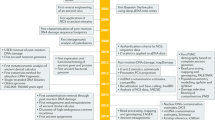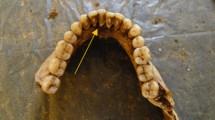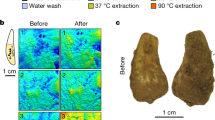Abstract
Mitochondrial DNA (mtDNA) was extracted from teeth stored from 3 months to 20 years, including teeth from the semi–skeletonized remains of a murder victim which had been buried for 10 months. Tooth donors and/or their maternal relatives provided blood or buccal cells, from which mtDNA was also extracted. Enzymatic amplification and direct sequencing of roughly 650 nucleotides from two highly polymorphic regions of mtDNA yielded identical sequences for each comparison of tooth and fresh DNA. Our results suggest that teeth provide an excellent source for high molecular weight mtDNA that can be valuable for extending the time in which decomposed human remains can be genetically identified.
This is a preview of subscription content, access via your institution
Access options
Subscribe to this journal
Receive 12 print issues and online access
$209.00 per year
only $17.42 per issue
Buy this article
- Purchase on Springer Link
- Instant access to full article PDF
Prices may be subject to local taxes which are calculated during checkout
Similar content being viewed by others
References
Saiki, R.K., Buguwan, T.L., Horn, G.T., Mullis, K.B. & Erlich, H.A. Primer-directed enzymatic amplification of DNA with a semi-stable DNA polymerase. Science 239, 487–494 (1986).
Vigilant, L., Pennington, R., Harpending, H., Kocher, T.D. & Wilson, A.C. Mitochondrial DNA sequences in single hairs from a southern African population. Proc. natn. Acad. Sci. U.S.A. 86, 9350–9354 (1989).
King, M.C. In Molecular Genetic Medicine, Vol 1 (ed Friedmann, T) 117–131 (Academic Press, San Diego, 1991).
Innis, M.A. & Gelfand, D.H. In PCR Protocols (eds Innis, M.A., Gelfand, D.H. Sminsky, J.J. & White. T.J.) (Academic Press, San Diego, 1990).
Di Rienzo, A. & Wilson, A.C. Branching pattern in the evolutionary tree for human mitochondrial DNA. Proc. natn. Acad. Sci. U.S.A. 88, 1597–1601 (1991).
Sanger, F., Nicklen, S. & Coulson, A.R. DNA sequencing with chain-terminating inhibitors. Proc. natn. Acad. Sci. U.S.A. 74, 5463–5467 (1977).
Anderson, S. et al. Sequence and organization of the human mitochondrial genome. Nature 290, 457–465 (1981).
Aquadro, C.F. & Greenberg, B.D. Human mitochondrial DNA variation and evolution: analysis of nucleotide sequences from seven individuals. Genetics 103, 287–312 (1983).
Orrego, C. & King, M.-C. (1990) Determination of familial relationships. In PCR protocols (eds Innis, M.A., Gelfand, D.H. Sminsky, J.J. & White. T.J.) 416–426 (Academic Press, San Diego, 1990).
Horai, S. & Hayasaka, K. Intraspecific nucleotide sequence differences in the major non-coding region of human mitochondrial DNA. Am. J. hum. Genet. 46, 828–842 (1990).
Vigilant, L. Control region sequences from African populations and the evolution of human mitochondrial DNA. PhD dissertation, University of California, Berkeley (1990).
Stoneking, M., Hedgecock, D., Higuchi, R.G., Vigilant, L. & Erlich, H.A. Population variation of human mtDNA control region sequences detected by enzymatic amplification and sequence-specific oligonucleotide probes. Am. J. hum. Genet. 48, 370–382 (1991).
Ward, R.H., Frazier, B.L., Dew-Jager, K. & Paabo, S. Extensive mitochondrial diversity with a single Amerindian tribe. Proc. Natn. Acad. Sci. U.S.A. 88, 8720–8724 (1991).
Hagelberg, E., Sykes, B. & Hedges, R. Ancient bone DNA amplified. Nature 342, 485 (1989).
Horai, S., Hayasaka, K., Murayama, K., Wate, N., Koike, H., & Nakai, N. DNA amplification from ancient human skeletal remains and their sequence analysis. Proc. Japan Acad., Ser. B 65, 229–233 (1989).
Hanni, C., Laudet, V., Sakka, M., Begue, A. & Stehelin, D. Amplification de fragments d'ADN mitochondrial a partir de dents et d'os humains anciens. C R Acad. Sci. Paris III 310, 365–370 (1990).
Hagelberg, E. & Clegg, J. Isolation and characterization of DNA from archaeological bone. Proc. R. Soc. Lond. B 244, 45–50 (1991).
Hagelberg, E., Gray, I.C. & Jeffreys, A. Identification of the skeletal remains of a murder victim by DNA analysis. Nature 352, 427–429 (1991).
Giles, R.E., Blanc, H., Cann, H.M. & Wallace, D.C. Maternal inheritance of human mitochondrial DNA. Proc. natn. Acad. Sci. U.S.A. 77, 6715–6719 (1980).
Gyllensten, U., Wharton, D. & Wilson, A. Maternal inheritance of mitochondrial DNA during backcrossing of two species of mice. J. Hered. 76, 321–324 (1985).
Cavalli-Sforza, L.L., Wilson, A.C., Cantor, C.R., Cook-Deegan, R. & King, M.C. Editorial. Call for a worldwide survey of human genetic diversity: A vanishing opportunity for the human genome project. Genomics 11, 490–491 (1991).
Author information
Authors and Affiliations
Rights and permissions
About this article
Cite this article
Ginther, C., Issel-Tarver, L. & King, MC. Identifying individuals by sequencing mitochondrial DNA from teeth. Nat Genet 2, 135–138 (1992). https://doi.org/10.1038/ng1092-135
Received:
Accepted:
Issue Date:
DOI: https://doi.org/10.1038/ng1092-135
This article is cited by
-
Current issues for mammalian species identification in forensic science: a review
International Journal of Legal Medicine (2021)
-
Genetic polymorphism analysis of mitochondrial DNA from Chinese Xinjiang Kazak ethnic group by a novel mitochondrial DNA genotyping panel
Molecular Biology Reports (2019)
-
Underlying Data for Sequencing the Mitochondrial Genome with the Massively Parallel Sequencing Platform Ion Torrent™ PGM™
BMC Genomics (2015)



